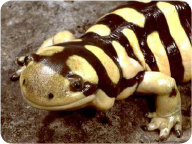 Barred Tiger Salamander
Barred Tiger Salamander
Ambystoma mavortium mavortium
Description
The Barred Tiger Salamander has a broad head and body. It is dark brown or black in color with a pattern of yellow bars. Juveniles are legless and breathe underwater with external gills.
Size
Barred Tiger Salamanders usually measure 6 to 8 inches in length.
Adaptations
- Salamanders have slimy, semi-permeable skin that secretes mucus and allows the animals to absorb moisture.
- Salamanders are able to re-grow limbs and tails that may be lost in encounters with predators.
- The color of the Barred Tiger Salamander helps it to blend in with leaf litter found on the ground.
- The Barred Tiger Salamander has poisonous glands near its tail that can produce a milky toxic substance if an animal attempts to eat the salamander.
Diet
Barred Tiger Salamanders consume a variety of invertebrate prey, including insects, slugs, and earthworms. At Cosley Zoo, the salamanders are fed crickets, earthworms, and a vitamin supplement.
Reproduction
These salamanders breed in early spring after a heavy rain. Breeding takes place in shallow bodies of water. Females lay eggs and attach them to underwater plants, where they incubate for about 3 weeks. Juveniles are completely aquatic, breathing with gills instead of lungs. They are also legless. After about a year, the young salamanders will metamorphosize (change) into terrestrial adults that have legs and breathe with lungs.
Shelter and Space Needs
Tiger Salamanders live in moist environments where their skin will not dry out and they have standing water in which to lay their eggs. Tiger Salamanders spend a large portion of their lives underground in burrows. In the winter, tiger salamanders burrow deep into the ground and go into a dormant state.
Life Expectancy
Tiger Salamanders may live up to 15-20 years in captivity. Their life span in the wild is uncertain.
Importance to Man
Salamanders and other amphibians are known as “environmental indicators” because they are extremely sensitive to changes in the environment. A high mortality rate or an increase in birth defects can be a sign that an area is becoming polluted. Salamanders are also predators of some insect pests.
Fun Facts
- Salamander larvae can be distinguished from tadpoles (frog larvae) by the external gills that are found on the outside of their bodies.
- Tiger Salamanders do not drink. Instead, they absorb moisture through their skin while sitting in puddles or in wet mud.
- Scientists are studying how salamanders regenerate their limbs, hoping to apply that knowledge to human health care.
- The word “salamander” comes from the Greek word for “fire lizard”.
- Salamanders often make their homes in logs. As ancient people threw logs into a fire, the salamanders would run out to safety. This gave rise to the idea that salamanders were born from fire.





